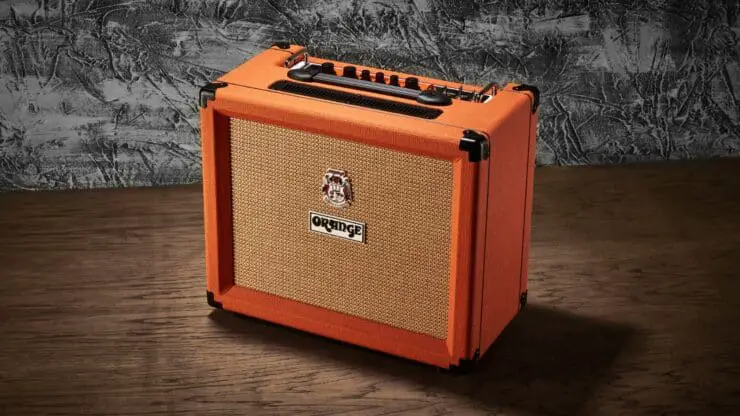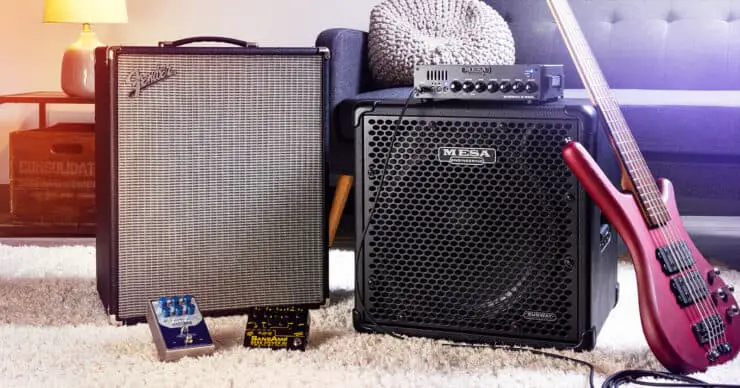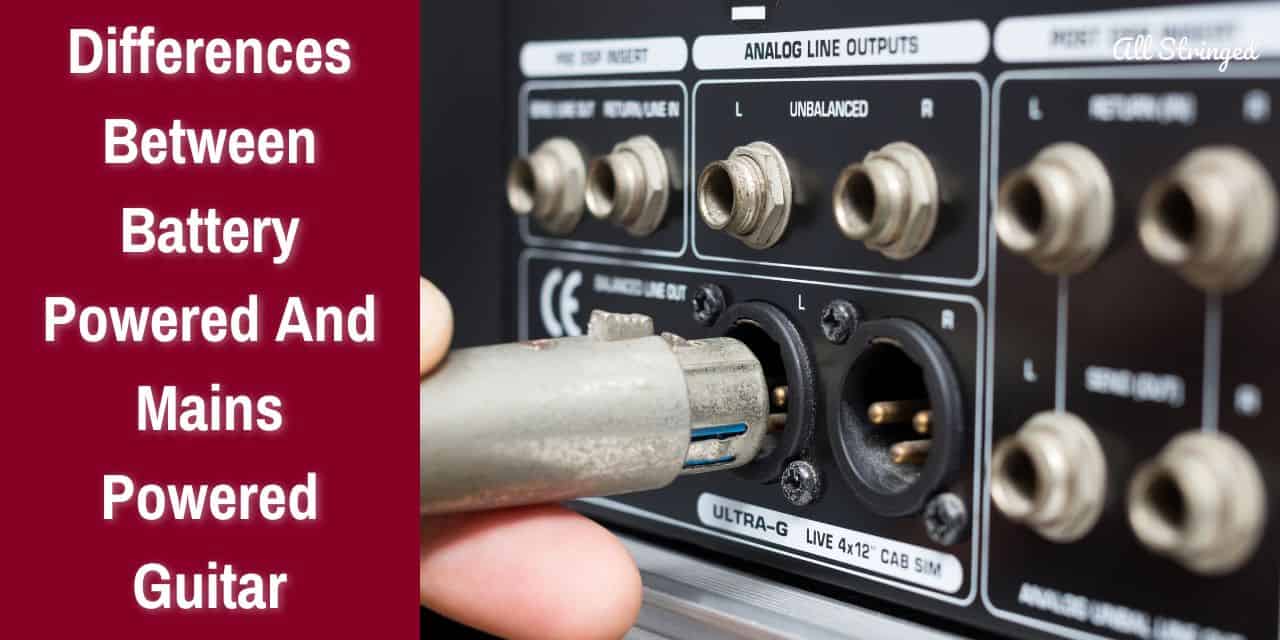Welcome, fellow guitar players! Are you wondering what the differences are between battery powered and mains powered guitar amplifiers? In this article, we’ll explore the pros and cons of each type of amplifier to help you make an informed decision when it comes to choosing the right one for your needs. Read on to discover the fascinating differences between these two types of amplifiers.
Overview of guitar amplifiers
Guitar amplifiers are the backbone of a guitarist’s sonic arsenal. This nifty addition to your music setup transforms the raw sound of an electric guitar into a rich and powerful audio experience. These devices play a key role in shaping the tone, volume, and overall character of the instrument.
>>> Click here to read our review about the Top 15 Best Battery Powered Guitar Amps <<<
A guitar amplifier or also referred to as an “amp” is an electronic device that amplifies the electrical signal generated by an electric or electro-acoustic guitar. The primary function of a guitar amp is to take the weak electrical signal from the guitar’s pickups and boost it to a level ideal for driving loudspeakers. This amplification process enhances the guitar’s volume and tone, allowing it to be heard more clearly and with greater impact.
When it comes to crafting the perfect sound for your electric guitar, choosing the right amp is a crucial decision. Guitar amps come in various types, each with its unique characteristics and sonic qualities. The different types of guitar amplifiers are tube amps, solid-state amps, digital modeling amps, battery-powered amps, and hybrid amps.
Tube amplifiers
Tube amplifiers or also known as valve amplifiers hold a special place in the hearts of many guitarists. These amps make use of vacuum tubes to amplify the guitar signal, providing a warm, rich, and organic sound. Tube amps are renowned for their dynamic response and natural overdrive when pushed to higher volume levels, creating a pleasing saturation typically associated with vintage tones.
Tube amps offer a wide range of tonal possibilities, making them versatile choices for various music genres, including rock, blues, and classic rock. However, they tend to be more expensive and require occasional maintenance as tubes might need replacement over time.

Solid-state amplifiers
Solid-state amplifiers make use of semiconductor components, such as transistors and integrated circuits to amplify the guitar signal. These amps are prized for their reliability, affordability, and lightweight design. Solid-state amps produce a clean and precise sound, making them ideal for genres like country, jazz, and pop, where a clean tone is often preferred.
While solid-state amps lack the warm overdrive of tube amps, they excel in delivering a consistent and dependable performance. This makes them a popular choice for practice, small gigs, and musicians seeking a straightforward and reliable amp option.
Digital modeling amplifiers
Digital modeling amplifiers employ advanced Digital Signal Processing (DSP) technology for simulating the sounds of various classic and modern amps. These versatile amps are able to replicate the tone of tube, solid-state, and vintage amps, offering an impressive range of sounds in a single package.
These amps allow guitarists to experiment with different amp models, effects, and speaker simulations, making them perfect for musicians and guitarists who crave versatility and enjoy exploring diverse sonic possibilities. They’re popular choices for musicians who play various genres and seek flexibility in crafting their unique sound.
Hybrid amplifiers
Hybrid amplifiers combine the characteristics of both tube and solid-state amps. They feature a tube preamp for warmth and a solid-state power amp for efficiency. Hybrid amps aim to provide the best of both worlds, offering a balance between tone and cost-effectiveness.
Battery-powered amplifiers
Battery-powered amplifiers are compact, portable, and ideal for musicians on the go. These amps are equipped with built-in rechargeable batteries or use standard batteries, allowing players to take their music anywhere, ether it is for outdoor performance, busking, or practicing on the move.
These amps come in different sizes and power ratings, ranging from small practice amps to more robust and feature-rich units. While they might not offer the same output and sonic capabilities as larger amps, battery-powered amps provide convenience and portability for musicians who need to play in different settings.
What are the differences between battery powered and mains powered guitar amplifiers?
When it comes to choosing the perfect guitar amp, musicians and guitarists often find themselves weighing the pros and cons of different options. Two popular choices that they often turn to are battery-powered guitar amplifiers and mains-powered guitar amplifiers. Each type of guitar amp offers unique features and capabilities. This is why understanding what are the differences between battery powered and mains powered guitar amplifiers will help you make a smarter decision based on your playing needs and preferences. Here are some of the common differences between battery-powered guitar amps and mains powered guitar amps.
#1. Power output
Battery-powered guitar amps typically come with lower power output compared to mains-powered guitar amps. These amps are designed to be portable and operate on battery power, which limits their overall wattage. While battery-powered guitar amps are ideal for practice sessions, smaller performances, and casual jamming, they may not offer enough volume or projection for larger venues or live gigs where higher power is needed.
Meanwhile, mains-powered guitar amps offer higher power output and wattage. These amps draw electricity directly from the main power supply, allowing them to offer substantial volume and projection. These amps are well-suited for professional performances, studio recording sessions, and gigs in larger venues, where a strong and clear sound is important.
#2. Portability
Portability is one of those aspects where battery-powered guitar amps truly shine. These guitar amps are compact, lightweight, and free from the need for power cords, which makes them highly portable and ideal for musicians on the move. They’re perfect for small gigs, street busking, practice sessions, and outdoor performances in unconventional locations as they do not rely on electrical outlets.
Mains-powered guitar amps tend to be larger and heavier because of the inclusion of high-quality components like vacuum tubes or powerful transformers. While they offer excellent performance and sound quality, their larger size and weight can make them less convenient for musicians who frequently have to transport their equipment between venues.

#3. Cost
Battery-powered guitar amps are typically more affordable than mains-powered amps. They typically have simpler designs and lower power output, which contributes to their cost-effectiveness. Moreover, these amps might not require the replacement of tubes or other high-end components, reducing long-term maintenance expenses.
Mains-powered guitar amps, especially the ones with premium components like vacuum tubes, tend to be more expensive compared to battery-powered counterparts. The higher-quality materials and construction of these amps can result in a higher price tag. Moreover, the maintenance and periodic replacement of tubes can add to the overall ownership cost.
#4. Power source
The most fundamental difference between battery-powered and mains-powered guitar amps is their source of power. As the name suggests, battery-powered guitar amps run on batteries, which makes them highly portable and independent of electrical outlets. These amps are perfect for practicing on the go, street performances, outdoor jam sessions, or any setting where you’re struggling for access to mains power.
Mains-powered guitar amps draw their power directly from electrical outlets. They need a stable connection to the mains power supply, which means that they’re best suited for performances in indoor venues, studios, or situations where access to reliable electrical power is available.
#5. Sound quality
While battery-powered guitar amps can produce decent sound quality, they may not match the rich and nuanced tones of higher-end mains-powered amps, particularly the ones that come equipped with premium components like vacuum tubes. The rather simple design and power output of battery-powered guitar amps means there is an unwanted limitation in terms of tonal versatility.
Meanwhile, mains-powered guitar amps are often praised for their superior sound quality, responsiveness, and tonal depth. The high-quality components and larger power output allow for cleaner and more transparent sound at higher volumes. These amps are favored by professional musicians and recording artists looking for exceptional sonic capabilities.
Advantages of battery-powered guitar amplifiers
For guitarists, looking for the perfect balance between convenience, portability, and high-quality sound is important, especially when it comes to practice, small performances, and jamming on the go. Battery-powered guitar amps have emerged as a versatile and valuable solution, offering an impressive range of advantages that cater to the needs of modern musicians. Here are some of the advantages of battery-powered guitar amps, highlighting why they have become such an indispensable tool for musicians and guitarists around the world.
#1. Quick to set up and tear down
Setting up a battery-powered guitar amp is a breeze. With no requirement of finding power sources or dealing with tangled cords, you’ll be able to get it up and running within seconds. This quick and hassle-free set-up is especially beneficial for musicians who need to move between locations swiftly, such as gigging musicians playing at multiple venues in a single day.
#2. Portability
A significant benefit of battery-powered guitar amps is their portability and mobility. These amps are designed to be compact and lightweight, allowing guitarists to carry them easily where they go. Whether you are playing in a park, practicing in your backyard, or jamming with friends, a battery-powered amp will free you from you constraints of finding a power outlet. This mobility opens up a plethora of new possibilities for spontaneous creativity and musical expression in various settings.
#3. Ideal for outdoor performances
Battery-powered amps are a boon for musicians who frequently perform outdoors or in places without access to electricity. Buskers, street performers, and musicians at small outdoor events can rely on these amps to deliver their sound without the need for power cables and extension cords. This convenience and self-sufficiency make these amps a popular choice for musicians who love performing in unconventional venues.
#4. Practice at home or outdoors
Battery-powered guitar amps are amazing options for practicing at home, especially if you do not want to disturb others with loud volumes. Many models have headphone outputs, allowing you to practice silently. This makes them perfect for late-night or private practice sessions.
In fact, they are perfect for practice sessions anywhere, even when you are on the move. They allow you to practice in any room without being limited by the availability of electrical outlets. Whether you are in a hotel room, on a camping trip, or relaxing in your backyard, you’ll be able to plug in your guitar and play to your heart’s content.

#5. Energy efficiency
Modern battery-powered guitar amps are designed to be energy-efficient, allowing for extended playtime on a single charge. Rechargeable batteries are common in these guitar amps and many models offer long-lasting battery life, reducing the need for frequent battery replacements.
#6. Fun for young musicians
For aspiring young guitarists, battery-powered guitar amps offer a safe and manageable option for practicing and playing. Parents and teachers can be assured that these amps are self-contained and do not need plugging into electrical outlets, reducing potential hazards for children.
Disadvantages of battery-powered guitar amplifiers
Battery-powered guitar amps have gained a lot of popularity among musicians. While these compact and self-contained amps offer a wide range of advantages, there is another side of the coin as well. There are certain disadvantages of battery-powered guitar amps that you must know about. Here are some of the limitations and drawbacks that come with using battery-powered guitar amps.
#1. Limited power and volume
One of the major drawbacks of battery-powered guitar amps is the limited power output they provide. These amps typically have lower wattage compared to their mains-powered counterparts. This limitation can affect the overall volume and projection, making them less suitable for larger venues or performances requiring higher output levels.
#2. Short battery life and constant need for charging
While many modern battery-powered guitar amps feature energy-efficient designs and rechargeable batteries, their overall battery life might still be limited. Continuous use at high volumes can end up draining the batteries quickly, resulting in frequent recharging or replacement. This factor can be a cause of concern during extended practice sessions, performances, or situations where access to power sources is limited.
For amps having rechargeable batteries, regular charging and battery maintenance are necessary. Musicians have to ensure that the batteries are charged and in good condition before performances or practice sessions. Failure to maintain batteries properly can result in unexpected power shortages during crucial moments.
#3. Sound quality
Battery-powered guitar amps might not have the potential to match the sound quality and tonal characteristics of higher-end mains-powered amps, especially those equipped with premium components like tubes or high-quality solid-state circuitry. The relatively simple and compact design of battery-powered amps might limit their ability to produce the depth and complexity of sound that professional musicians often seek.
#4. Limited features and effects
Due to their size and energy constraints, battery-powered guitar amps might have fewer features and built-in effects compared to larger, mains-powered amps. Musicians who rely on built-in effects like delay, reverb, or modulation might find battery-powered guitar amps lacking in this aspect.
#5. Inconsistent performance
Battery-powered guitar amps can exhibit consistent performance as the batteries deplete. As the battery level drops, the amp’s output might decrease, affecting the overall volume and tone. This inconsistency can be challenging during performances or recording sessions when a challenging and reliable sound is important.
Advantages of mains-powered guitar amplifiers
Mains-powered guitar amplifiers have been a staple in the music industry for decades, serving as a reliable and powerful tool for musicians worldwide. These amps are connected to a main power source, offering a consistent and robust performance that meets the demands of professional musicians and enthusiasts alike. Here are some of the advantages of mains-powered guitar amps, highlighting why they remain the go-to option for many musicians and guitarists.
#1. High power output and volume
One of the biggest advantages of mains-powered guitar amps is their high power output and volume capabilities. These amps are able to deliver substantial wattage, making them perfect for larger venues, concerts, and performances where higher volume levels are needed. The ability to project sound over long distances ensures that the guitar’s voice can be heard clearly and effectively.
#2. Improved sound quality
Mains-powered guitar amps often boast higher-quality components, such as vacuum tubes or high-end solid-state circuitry, resulting in superior sound quality. These amps are capable of producing rich, dynamic, and nuanced tones that resonate with musicians and audiences alike. The added headroom and power reserve allow for cleaner and more transparent sound at higher volumes, making them suitable for various musical genres.
#3. Wide range of features and effects
Mains-powered guitar amps typically offer an impressive array of built-in features and effects that enhance versatility and creativity. Delay, reverb, modulation, and other effects are commonly integrated into these amplifiers, allowing guitarists to experiment and shape their sound to match their artistic vision. The availability of footswitch compatibility further expands the guitar amp’s functionality during live performances.
#4. Consistent performance
Mains-powered guitar amplifiers offer consistent performance throughout their usage. Unlike battery-powered guitar amps that may experience a decrease in volume and tone as the batteries gradually deplete, mains-powered guitar amps maintain stable performance as long as they’re connected to a reliable power source.
#5. Extended playtime and reliability
With access to mains power, guitarists are able to enjoy extended playtime without worrying about battery life or frequent recharging. This reliability is important during extended practice sessions, rehearsals, and lengthy performances where consistent power is needed.
#6. Ideal for all musical styles
Mains-powered guitar amps are well-suited for a wide range of musical styles. Whether you play jazz, blues, rock, country, metal, or any other genre, these guitar amps are able to deliver the power and tonal versatility required for complementing your musical expression.
Disadvantages of mains-powered guitar amplifiers
Mains-powered guitar amplifiers have long been a popular choice among musicians due to their high power output, reliable performance, and impressive sound quality. Yes, they do offer a lot of benefits, but they also come with their share of limitations and drawbacks. Here are some of the disadvantages of mains-powered guitar amps.
#1. Lack of portability
One of the most apparent drawbacks of mains-powered guitar amps is their lack of portability. These amps require a direct connection to a main power source, which can limit their usage in settings where access to power outlets might be limited or non-existent.
Musicians who often play in outdoor venues, street performances, or remote locations might find mains-powered amps impractical due to the need for power cords and access to electrical outlets.
#2. Size and weight
Mains-powered guitar amps tend to be bigger and heavier compared to their battery-powered counterparts. The inclusion of high-quality components, such as vacuum tubes or powerful transformers, contributes to the weight and size of these amps. This bulkiness can make transportation and setup much more challenging, especially for musicians who can frequently gig in various locations.
#3. Dependency on power sources
Using a mains-powered guitar amp relies heavily on having access to reliable electrical power sources. In situations where power outages occur or during outdoor performances without access to power, mains-powered guitar amplifiers become unusable, potentially disrupting live shows or practice sessions.
#4. Limited outdoor performance flexibility
Even when mains power is available, outdoor performances can present challenges for mains-powered guitar amps. The need for long power cords and the potential for accidental tripping hazards might hinder the freedom of movement on stage.
#5. Unsuitability for busking and street performances
For musicians who engage in busking and street performances, mains-powered guitar amplifiers aren’t practical due to the need for power outlets. These amps offer more convenience and mobility in these scenarios.
#6. Cost and maintenance
Mains-powered guitar amplifiers, especially those with high-end components like vacuum tubes can be more expensive than battery-powered alternatives. Moreover, maintenance costs and the need to replace tubes periodically can add to the overall ownership expenses.
FAQs
What is the difference between battery powered and mains powered guitar amplifiers?
Battery powered guitar amplifiers run on batteries and are designed to be portable and convenient. They are ideal for practicing on the go, as they do not require a power outlet. Mains powered guitar amplifiers must be plugged into a power outlet and are typically larger, louder, and more powerful than battery powered amps.
What are the benefits of a battery powered guitar amplifier?
The main benefit of a battery powered guitar amplifier is its portability. Battery powered amps are lightweight and easy to carry, making them ideal for practice on the go. They are also typically more affordable than mains powered amps.
What are the benefits of a mains powered guitar amplifier?
Mains powered guitar amplifiers offer more power and volume than battery powered amps, making them ideal for live performances and recording sessions. They also typically have more features, such as reverb, chorus, and delay effects.



